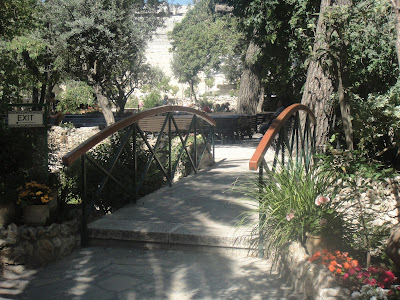During my recent Israel trip, we (as in me and my mum and our tour mates) stayed three nights in Tiberias in the Galilee area, and four nights in Jerusalem. The hotels we were given are not too bad, and comes with buffet breakfast and dinner.
In fact, for Tiberias, we were given a hotel that faces the Sea of Galilee, so in the morning, we could go for walks along the coast of the Sea of Galilee, and see the sunrise and sunset over the water. There is also a spa of sorts opposite so we went to the jacuzzi and pool there during one of the evenings. This is free for our hotel guests. We only need to go to the reception to get a towel and make our way to the spa.
In Tiberias, the hotel we stayed in is called Rimonim Mineral Tiberias Hotel. What I like is the revolving door! We got a double room with two twin beds, attached bathroom and bathtub, with a balcony that has a view of the Sea of Galilee. Housekeeping is available everyday and the staff is friendly. The moment we arrived, we were given a welcome refreshing citrus drink.
The room is not too bad. There is a little sofa and a foldable multi hanger to dry our clothes. The only gripe is that there is not enough electricity sockets for us to charge our phones, cameras and my mum's iPad. In fact, the wall socket she was using does not seem to be working well as her gadget could only be charged halfway. Other than that, the room is pretty okay.
However, there is no free Wifi though. We need to have a password and pay a certain amount for an hour or so before using the internet. Hence, we did not use the internet at all throughout our stay there. We rather use the free Wifi provided in our coach.
Rimonim Mineral Hotel, where we stayed in Tiberias
I like the revolving door!
View of the Sea of Galilee from our hotel room
Sunrise over the Sea of Galilee
The spa opposite
In Jerusalem, the hotel we stayed in is a local kibbutz hotel called Ramat Rachel. The meaning of a kibbutz means it used to be a farmhouse with a piece of land. Our hotel was converted from a kibbutz, and there is still a big garden and grounds within the compound. There is still remnants of the old stone and adobe architecture in the hotel.
Our room happened to be 666 - that number! But the room is bigger and cosier than that of Tiberias. Even though there is not much of a view except for the city of Jerusalem, we could still see sun setting in the horizon.
Again we have two twin beds, but this time, the beds are bigger size. There is a lounge sofa where we can lie down and read. No balcony but the windows are bigger. The bathroom has more facilities, like a floor mat, and bigger space for wash basin, and more electricity sockets that work perfectly!
Most importantly, there is free Wifi! But only in the lobby. The Wifi in the rooms are not free. So for those who wish to surf the internet, they will go to the lobby to utilise the free Wifi. This hotel also comes with a Sabbath Elevator, that will not work on Saturdays. In fact, on Saturdays before half past eight in the evening where the Sabbath ends, the lift will automatically go to every floor and we cannot press the buttons to bring us to our desired level. But it is working well on the other days and timings.
Lobby area
First time I came across a Sabbath Elevator
Our room - what a number right?
View from our hotel room
Dining area where we had our breakfasts and dinners
This corridor leads to the lobby
Grounds of the hotel
Wedding Canopy for Jewish weddings
My verdict? I think the Jerusalem hotel is better. There are lots of hotels in Tiberias and Jerusalem, ranging from very high class like King David to mid-priced like Leonardo. But I have no complaints about our hotel, since we only go there to rest, eat and sleep, and nothing else. So it was good enough that we managed to live in pretty comfortable lodgings throughout our stay and we could actually rest enough!


































































